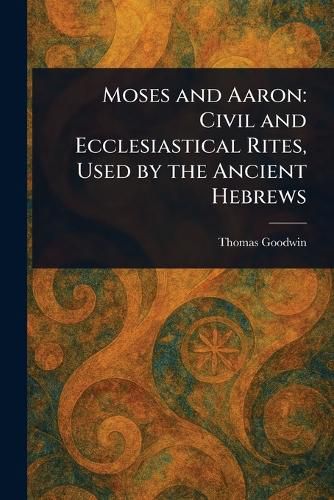Readings Newsletter
Become a Readings Member to make your shopping experience even easier.
Sign in or sign up for free!
You’re not far away from qualifying for FREE standard shipping within Australia
You’ve qualified for FREE standard shipping within Australia
The cart is loading…






This title is printed to order. This book may have been self-published. If so, we cannot guarantee the quality of the content. In the main most books will have gone through the editing process however some may not. We therefore suggest that you be aware of this before ordering this book. If in doubt check either the author or publisher’s details as we are unable to accept any returns unless they are faulty. Please contact us if you have any questions.
Explore the intricacies of ancient Hebrew life and worship in Thomas Goodwin's "Moses and Aaron: Civil and Ecclesiastical Rites, Used by the Ancient Hebrews." This enduring work delves into the religious history and practices detailed in the Old Testament, providing a comprehensive look at the rites and ceremonies associated with figures like Moses and Aaron.
Goodwin meticulously examines the rituals and customs that shaped early Hebrew society, offering valuable insights into their religious and social structures. A cornerstone of Biblical studies, this book explores the foundations of Judaism, focusing on rituals and practices. Students of religion, history enthusiasts, and anyone interested in the roots of religious tradition will find this exploration of Hebrew rites both informative and illuminating.
This work has been selected by scholars as being culturally important, and is part of the knowledge base of civilization as we know it.
This work is in the public domain in the United States of America, and possibly other nations. Within the United States, you may freely copy and distribute this work, as no entity (individual or corporate) has a copyright on the body of the work.
Scholars believe, and we concur, that this work is important enough to be preserved, reproduced, and made generally available to the public. We appreciate your support of the preservation process, and thank you for being an important part of keeping this knowledge alive and relevant.
$9.00 standard shipping within Australia
FREE standard shipping within Australia for orders over $100.00
Express & International shipping calculated at checkout
This title is printed to order. This book may have been self-published. If so, we cannot guarantee the quality of the content. In the main most books will have gone through the editing process however some may not. We therefore suggest that you be aware of this before ordering this book. If in doubt check either the author or publisher’s details as we are unable to accept any returns unless they are faulty. Please contact us if you have any questions.
Explore the intricacies of ancient Hebrew life and worship in Thomas Goodwin's "Moses and Aaron: Civil and Ecclesiastical Rites, Used by the Ancient Hebrews." This enduring work delves into the religious history and practices detailed in the Old Testament, providing a comprehensive look at the rites and ceremonies associated with figures like Moses and Aaron.
Goodwin meticulously examines the rituals and customs that shaped early Hebrew society, offering valuable insights into their religious and social structures. A cornerstone of Biblical studies, this book explores the foundations of Judaism, focusing on rituals and practices. Students of religion, history enthusiasts, and anyone interested in the roots of religious tradition will find this exploration of Hebrew rites both informative and illuminating.
This work has been selected by scholars as being culturally important, and is part of the knowledge base of civilization as we know it.
This work is in the public domain in the United States of America, and possibly other nations. Within the United States, you may freely copy and distribute this work, as no entity (individual or corporate) has a copyright on the body of the work.
Scholars believe, and we concur, that this work is important enough to be preserved, reproduced, and made generally available to the public. We appreciate your support of the preservation process, and thank you for being an important part of keeping this knowledge alive and relevant.